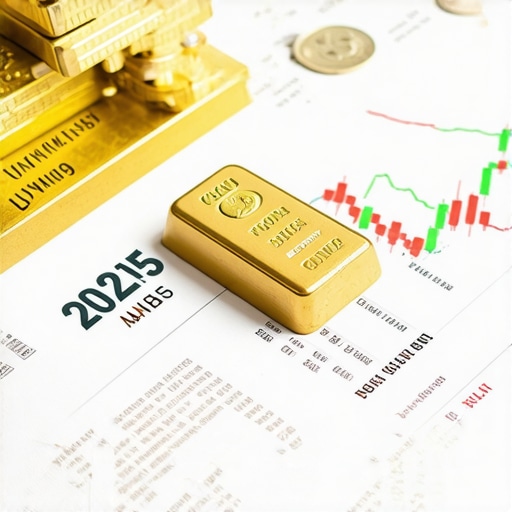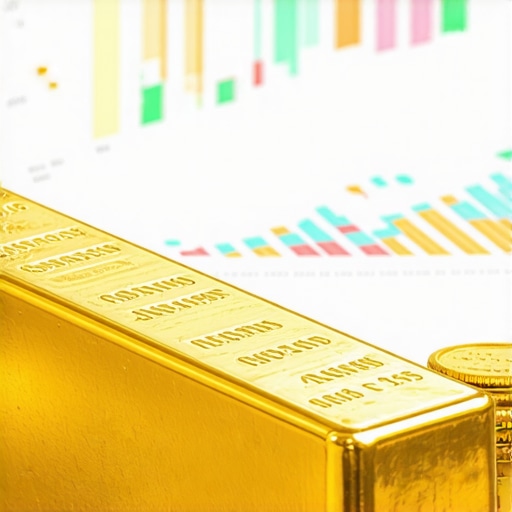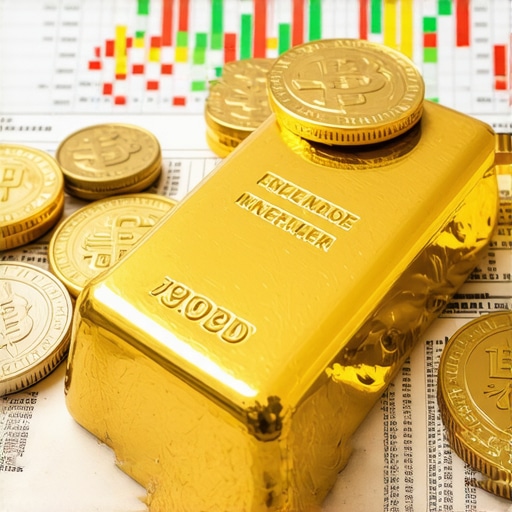Why I Started Balancing Gold and Stocks in My Portfolio
When I first began investing, I was all in on stocks, chasing fast growth and market trends. It wasn’t until a market downturn shook my confidence that I realized the importance of diversification beyond just equities. That’s when I started exploring gold as an investment to complement my stock holdings. Balancing gold vs stocks became a personal mission to secure my portfolio against volatility and inflation. Over the years, I’ve learned several strategies that helped me maintain equilibrium and growth.
Discovering the Protective Power of Gold in My Portfolio
Gold has a unique role as a hedge against economic uncertainty. I found that during times of market stress, gold prices often moved inversely to stocks, providing a buffer to my overall investments. This insight aligns with what many experts note about gold’s ability to protect wealth during inflationary periods and geopolitical tensions. For instance, I often refer to trusted resources like how gold acts as a hedge against inflation to deepen my understanding of this dynamic.
How Do I Decide the Right Gold-to-Stocks Ratio?
One question I frequently get asked is: “How much gold should I hold relative to stocks?” From my experience, it depends on your risk tolerance and investment goals. I personally allocate between 10-20% of my portfolio to gold, mostly through a mix of physical gold bars and gold ETFs. This blend offers both security and liquidity. If you’re curious about safe ways to buy and store gold bars, I recommend checking out trusted dealer tips that helped me avoid common pitfalls.
Integrating Gold Stocks for Growth and Stability
Besides physical gold and ETFs, I’ve also invested in gold stocks to capture additional growth potential. Mining companies and gold-related equities can amplify returns, though they come with their own risks. I learned this by carefully studying market trends and expert analyses like those found in long-term benefits of gold stocks. Balancing these with traditional stocks requires ongoing attention but can enhance portfolio resilience.
My Personal Strategy for a Balanced Portfolio
In practice, I rebalance my portfolio annually, adjusting gold and stock proportions based on market conditions and my financial goals. This keeps me grounded and prepared for volatility. I also diversify my gold investments across physical bars, ETFs, and stocks, which I’ve found reduces risk while maximizing potential returns. For anyone looking to build a similar balanced approach, resources like how to create a balanced portfolio with gold ETFs and stocks provide excellent guidance.
If you have experiences or tips about balancing gold and stocks in your portfolio, I’d love to hear your thoughts—feel free to share in the comments below!
Adjusting Your Gold-Stock Allocation Amid Market Cycles
One of the nuanced lessons I’ve learned is that the ideal gold-to-stock ratio isn’t static over time. Economic cycles, interest rate changes, and geopolitical risks all influence the optimal balance. During periods of rising inflation or market uncertainty, increasing gold exposure can provide further portfolio insulation. Conversely, in strong bull markets, a heavier stock weighting might better capture growth opportunities. This dynamic approach requires monitoring macroeconomic indicators and adjusting allocations accordingly.
What Advanced Metrics Can Investors Use to Optimize Gold and Stock Balances?
Beyond simple percentage allocations, I utilize metrics such as the correlation coefficient between gold and equities, volatility indices, and real interest rate trends to fine-tune my portfolio. For example, a low or negative correlation between gold and stocks suggests a diversification benefit, justifying a larger gold allocation. Additionally, tracking real interest rates helps anticipate gold demand since gold often outperforms when real yields are negative. These quantitative tools empower investors to make data-driven adjustments rather than relying solely on intuition.
For those interested in delving deeper into gold demand analytics, the comprehensive analysis of gold demand trends provides invaluable insights into supply-demand drivers and price implications in 2025 and beyond.
Incorporating Tactical Rebalancing and Hedging Techniques
While annual rebalancing is a solid baseline, I’ve found that tactical rebalancing—adjusting allocations in response to short-term market signals—can enhance portfolio performance. For instance, if equities appear overvalued or if geopolitical tensions rise unexpectedly, temporarily increasing gold exposure serves as a strategic hedge. This requires staying informed through reliable financial news and leveraging technical analysis tools to identify entry and exit points.
Moreover, using derivative instruments like gold futures or options can provide additional hedging flexibility. These tools enable investors to protect gains or limit downside risk without liquidating physical holdings or stocks. However, they come with complexity and risk, so education and cautious application are essential.
Balancing Liquidity Needs with Gold Investment Choices
Another practical consideration is liquidity. Physical gold bars offer strong security but can be less liquid and incur higher transaction costs compared to gold ETFs or stocks. For investors who might need quick access to funds, maintaining a portion of gold holdings in more liquid forms is prudent. My personal approach includes a core holding in physical bullion for stability, complemented by ETFs for flexibility and stocks for growth potential.
This layered strategy aligns with guidance on exploring different types of gold investments to match individual goals and liquidity preferences.
If you’ve experimented with tactical rebalancing or use advanced metrics to balance your gold and stocks, please share your experiences or questions in the comments. Your insights can enrich our collective understanding and help fellow investors refine their strategies.
Reflecting on the Emotional Discipline Behind Gold and Stock Balancing
One aspect often overlooked in the gold versus stocks balancing act is the emotional discipline required to maintain your strategy through market swings. I’ve noticed that my own reactions to sudden market shifts sometimes tempted me to deviate from my planned allocations. For instance, during bouts of euphoria in the stock market, the urge to overweight equities felt strong, while geopolitical crises pulled me toward increasing gold holdings impulsively. Recognizing these emotional biases has been crucial in sticking to a thoughtfully constructed plan that incorporates both assets for long-term resilience.
Building that emotional resilience meant developing trust in my research and strategies, including insights from authoritative sources like analysis of gold demand trends in 2025, which helped me understand broader market forces beyond short-term noise.
Balancing Act Complexity: When Does Gold Become a Riskier Asset Than Stocks?
This question often surfaces when gold prices experience volatility or when mining stocks react sharply to operational risks. While gold is traditionally viewed as a safe haven, its price can be influenced by factors like central bank policies, mining supply disruptions, or shifts in investor sentiment. For example, during certain market cycles, gold stocks can behave more like cyclical equities rather than stable hedges.
How Do You Evaluate When Gold Might Add Risk Instead of Mitigating It?
From my experience, it’s essential to monitor gold’s correlation with other market assets continuously and interpret macroeconomic signals carefully. A particularly telling sign is when gold’s correlation to stocks turns positive for an extended period, often signaling a broader risk-on environment. Additionally, understanding supply-side dynamics through resources like evaluating gold supply dynamics has helped me anticipate shifts in gold’s risk profile.
In these moments, I sometimes reduce my allocation to gold stocks or physical gold temporarily, reallocating to cash equivalents or alternative assets to preserve capital. This nuanced approach differs from the simplistic notion that gold is inherently risk-free and highlights how advanced portfolio management demands vigilance and flexibility.
Embracing Technology: How Digital Tools Enhance My Portfolio Management
Another layer to this balancing act is leveraging technology. I’ve integrated portfolio management software that tracks real-time price movements, correlation metrics, and volatility indices, which allows me to make more informed and timely adjustments. These tools often include predictive analytics that factor in macroeconomic forecasts, such as inflation expectations and central bank gold purchases, which are critical drivers I monitor closely.
For those interested, exploring platforms that incorporate these data points can transform your approach from reactive to proactive. Combining this with educational resources like the ultimate guide to gold investments in 2025 helped me build a more sophisticated framework for decision-making.
Navigating the Tension Between Tradition and Innovation in Gold Investing
One of the more personal tensions I grapple with is balancing the allure of traditional physical gold with newer digital investment vehicles. Physical gold offers tangibility and a psychological comfort that digital assets sometimes lack, yet ETFs and digital gold products provide convenience and liquidity that align well with modern investing needs.
Reconciling these two sides means accepting trade-offs and tailoring my portfolio to evolving goals. For example, I maintain a core position in physical gold bars stored securely, while experimenting with emerging digital gold platforms that offer fractional ownership and seamless trading. This blend captures heritage and innovation, a balance that resonates with my evolving perspective on wealth preservation and growth.
If you’ve also explored this intersection or have insights on managing the risks and benefits between physical and digital gold, I invite you to share your stories or questions below. Our collective experiences can illuminate paths through this complex landscape.
Harnessing Quantitative Analytics to Refine Gold and Stock Allocations
My journey into portfolio optimization advanced significantly once I integrated sophisticated quantitative tools to evaluate the interplay between gold and equities. Moving beyond the simplistic heuristics of fixed percentage allocations, I now emphasize metrics like rolling correlation coefficients, Sharpe ratios adjusted for inflation, and regime-switching models that identify macroeconomic states favoring gold or stocks. For instance, by tracking the dynamic correlation trends, I can detect shifts in market sentiment — such as when gold and stocks start moving in tandem during risk-on environments, signaling a potential need to recalibrate my exposure.
Moreover, real interest rates remain a pivotal barometer in my decision matrix, given gold’s historic tendency to outperform when real yields dip below zero. Engaging with comprehensive data sets and expert analyses, such as the in-depth analysis of gold demand trends, has enriched my perspective on supply-demand factors that drive price dynamics beyond mere market noise.
How Can Investors Employ Predictive Models to Anticipate Optimal Gold-Stock Mixes?
Advanced investors might ask: “What predictive frameworks can we adopt to anticipate the best gold-to-stock ratios ahead of economic shifts?” In my practice, I leverage econometric models combining inflation forecasts, monetary policy signals, and geopolitical risk indices to estimate prospective volatility and asset correlations. Machine learning algorithms trained on historical cycles further refine these predictions, allowing for tactical rebalancing that is both proactive and data-driven. While no model guarantees perfect foresight, this structured approach mitigates emotional biases and enhances portfolio resilience.
Emotional Intelligence: The Understated Pillar in Portfolio Balancing
Investing is as much a psychological endeavor as it is analytical. Over time, I’ve recognized the paramount importance of emotional intelligence in maintaining discipline and adhering to my strategic allocations during turbulent periods. Emotional reactions—whether fear-induced panic selling or greed-fueled overexposure—can erode long-term portfolio stability.
To guard against this, I employ mindfulness and journaling techniques to track my emotional responses and decision rationales. This practice cultivates awareness and enables me to differentiate transient market noise from structural shifts. Additionally, my trust in authoritative, data-backed insights—like those found in the guide to avoiding common gold investment mistakes—reinforces my confidence in the strategy during volatile phases.
Innovating with Digital Gold Platforms While Honoring Traditional Values
Bridging tradition with innovation, I have progressively incorporated digital gold investment platforms offering fractional ownership and instantaneous liquidity. This evolution respects gold’s heritage as a tangible store of value while embracing the efficiencies demanded by today’s market environment. Yet, I remain vigilant about platform credibility and regulatory compliance, recognizing that the digital realm introduces novel risks alongside opportunities.
The synergy between physical holdings—secured through best practices advised by trusted gold dealer tips—and digital assets creates a diversified gold allocation that aligns with my liquidity needs and risk appetite. This multifaceted approach exemplifies how modern investors can tailor gold exposure to their unique financial narratives.
If you’re navigating this nuanced intersection of gold investing or refining your portfolio balancing techniques, I invite you to share your insights or questions below. Engaging in this dialogue enriches our collective expertise and fosters more resilient investment communities.
Things I Wish I Knew Earlier (or You Might Find Surprising)
Gold Isn’t Always the Calm in the Storm
Early on, I assumed gold was a foolproof safe haven that would never betray my trust. But I’ve learned that gold can experience volatility, sometimes behaving unpredictably due to factors like central bank actions or mining supply disruptions. Recognizing that gold carries its own risks has helped me avoid complacency and manage expectations better.
The Emotional Tug-of-War Is Real and Demanding
Balancing gold and stocks isn’t just a numbers game; it’s a test of emotional discipline. I’ve caught myself tempted to chase gains during stock market highs or panic-buy gold during crises. Developing awareness of these impulses and sticking to a well-reasoned plan has been crucial in protecting my portfolio’s long-term health.
Liquidity Matters More Than I Initially Thought
While physical gold has undeniable security, I underestimated how important liquidity is for flexibility. Having some gold in liquid forms like ETFs or gold stocks allows me to respond quickly to market changes without sacrificing my position in precious metals.
Technology Can Be a Portfolio’s Best Friend
Integrating digital tools for tracking price movements, correlations, and economic indicators transformed my approach from reactive to proactive. These tools helped me anticipate shifts and rebalance tactically rather than emotionally.
There’s No One-Size-Fits-All Allocation
I used to think there was a perfect gold-to-stocks ratio etched in stone. Now, I appreciate how dynamic this balance should be, adapting to market cycles, inflation trends, and personal goals. This flexibility has enhanced both resilience and growth.
Resources I’ve Come to Trust Over Time
Buying Gold Now is my go-to for comprehensive, well-researched insights. Their article on how gold acts as a hedge against inflation deepened my understanding of gold’s protective qualities.
Their analysis of gold demand trends helped me grasp the intricate supply-demand dynamics that influence price movements beyond the headlines.
For practical tips, the trusted dealer tips for buying and storing gold bars gave me peace of mind in handling physical gold securely.
When exploring the balance between gold ETFs and stocks, their guide on creating a balanced portfolio with gold ETFs and stocks offered actionable strategies that I still use today.
Lastly, the beginner’s guide on avoiding common gold investment mistakes helped me sidestep pitfalls early on, saving time and money.
Parting Thoughts from My Perspective
Balancing gold and stocks has been a journey of continual learning, emotional growth, and strategic adaptation. Gold is more than just a hedge; it’s a versatile asset that, when blended thoughtfully with stocks, can enhance portfolio resilience and opportunity. The key lies in flexibility—adjusting allocations with market cycles, leveraging technology, and cultivating emotional discipline.
From my experience, no rigid formula fits everyone, but embracing insights and trusted resources can empower you to craft a balance that suits your unique goals. If this resonated with you, I’d love to hear your thoughts or stories about your own gold and stock balancing journey. Feel free to drop your experiences or questions in the comments below—let’s learn and grow together.










